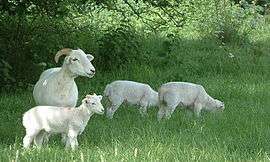Wiltshire Horn

The Wiltshire Horn is a breed of domestic sheep originally from Wiltshire in southern England raised for meat.[1] The breed is unusual amongst native British breeds, for it has the unusual feature of moulting its short wool and hair coat naturally in spring, alleviating the need for shearing.[2] They are good mothers and have high fertility. The fact that they do not require shearing or crutching and do not suffer readily from flystrike is making them increasingly attractive to the commercial sheep sector, particularly as even pure-bred lambs can reach slaughter weight in as little as 16 weeks.
History
The Wiltshire Horn was until the 18th century one of southern England's predominant sheep breeds. For hundreds of years, it served a clear function on the thin chalk soils of the Wiltshire Downs, requiring little shelter from the elements and providing dung and urine to fertilise the wheat-growing land. At the same time, it provided an easily managed source of quality meat, but the rising price of wool and a general move away from horned sheep saw the breed suffer a dramatic decline throughout the 19th and 20th centuries.
It was nearly extinct at the start of the 1900s. In 1923, in an attempt to save the breed, the Wiltshire Horn Breed Society was formed. In the early 1980s, there were 45 registered flocks in the UK,[3] but the 2009 edition of the Wiltshire Horn Sheep Society's flock book recognises almost 300 flocks.
The Wiltshire Horn is one of the foundation breeds for Katahdin, Wiltipoll and Easycare breeds.[3]
Until the 20th century, the breed was chiefly traded at local events such as the Westbury Sheep Fair.
Characteristics
Males and females both have horns. Ram horns will grow one full spiral each year until maturity. Both sexes are white with occasion black spots on the undercoat. This is a hair breed, growing a thick, coarse coat in the winter and shedding in the summer. Rams weigh about 250 pounds (110 kg) and ewes 150 pounds (68 kg).[3]
Farming
No longer a rare breed, the Wiltshire Horn is proving its worth to three particular groups of producers:
- The smaller-scale producer seeking added value with quality, naturally reared, full-flavoured meat.
- The large commercial operator can tap into Wiltshire Horn genetics and create wool-shedding hybrids, so freeing themselves from the expense and hassle of annual shearing;
- The smallholder and hobbyist who values the breed for its meat, its easy-to-handle conformation and its low-input, no-shear attributes.
References
- ↑ "Wiltshire Horn". Sheep Breeds V-Z. Sheep101.info. Retrieved 2009-05-07.
- ↑ "Wiltshire Horn Sheep Breed". RaisingSheep.net. Retrieved 31 July 2015.
- 1 2 3 "Wiltshire Horn". Breeds of Livestock. Oklahoma State University, Dept. of Animal Science. Retrieved 2009-05-07.
External links
- UK Wiltshire Horn Sheep Society
- Australian Wiltshire Horn Breeders Association
- Belgian breeder with extra information about this breed (only available in dutch)